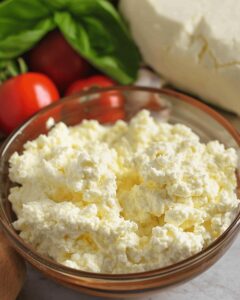Description
Homemade ricotta cheese brings Italian culinary magic to kitchen counters with minimal ingredients and simple techniques. Creamy, fresh results reward home cooks with a luxurious spreadable cheese you can savor on toast, salads, or pasta dishes.
Ingredients
Scale
Main Ingredients:
- ½ gallon (1.89 liters) whole milk
Main Acidifying Agent:
- 2 tablespoons (30 milliliters) lemon juice or apple cider vinegar
Seasoning:
- 1 teaspoon (5 grams) sea salt
Instructions
- Select a heavy-bottomed pot and combine whole milk and kosher salt, creating a creamy base for transformation.
- Gradually heat the milk mixture over medium-high temperature, stirring intermittently until it reaches 185°F (85°C) or develops a gentle steaming surface without aggressive boiling.
- Introduce freshly squeezed lemon juice or apple cider vinegar into the heated milk, which will instantaneously trigger protein separation.
- Reduce heat to medium and allow gentle chemical reaction to occur for approximately 60 seconds, observing delicate curdle formation.
- Remove pot from heat source and let the mixture rest undisturbed for 10-12 minutes, permitting complete protein coagulation.
- Prepare a large colander by lining it with four layers of clean cheesecloth, positioning it above a deep catching bowl to collect whey drainage.
- Carefully transfer the curdled milk mixture into the cloth-lined colander, allowing natural gravitational separation.
- Gently gather cheesecloth edges, creating a suspended pouch by tying corners and hanging over a wooden spoon across the pot’s rim.
- Allow ricotta to drain for 1.5-2 hours, depending on desired moisture consistency.
- Transfer the freshly crafted ricotta into a sealed glass container, refrigerating immediately for optimal preservation up to 5-7 days.
Notes
- Homemade cheese-making transforms simple ingredients into a creamy, luxurious spread with minimal kitchen effort.
- Whole milk provides the richest base, creating a smoother texture compared to low-fat alternatives.
- Freshly squeezed lemon juice works better than bottled varieties, delivering brighter acidic notes for optimal curdling.
- Draining time impacts final ricotta consistency, with shorter periods yielding softer cheese and longer durations producing firmer results.
- Storing ricotta in an airtight container helps maintain freshness and prevents absorption of other refrigerator odors.
- Leftover whey can be used for baking, smoothies, or watering plants, reducing kitchen waste and adding nutritional value.
- Prep Time: 10 minutes
- Cook Time: 20 minutes
- Category: Snacks, Appetizer
- Method: Simmering
- Cuisine: Italian
Nutrition
- Serving Size: 4
- Calories: 110
- Sugar: 1 g
- Sodium: 120 mg
- Fat: 9 g
- Saturated Fat: 5 g
- Unsaturated Fat: 4 g
- Trans Fat: 0 g
- Carbohydrates: 2 g
- Fiber: 0 g
- Protein: 7 g
- Cholesterol: 30 mg
